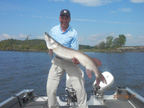
Posts: 3508
Location: Elk River, Minnesota | Actually, by definition, you are not cavitaing, you are ventilating. Cavitation is when the water behind the blade vaporizes (or in a sense boils) behind the blades. Cavitation is not good. It will cause deterioration of the blade.
Ventilating is when your motor increases RPM rapidly and is sucking surface air or exhaust fumes into the blades increasing slip and loss of handling.
By design, most motors are able to be lifted to it's highest bolt hole without damage to the lower unit. A pressure gauge is not a bad Idea, but as long as you have a good stream of water coming from your outlet, you should be fine.
In many cases, the cavitation plate can be above the lowest point of the boat. What needs to be remembered here is that the boat creates a hole in the surface of the water, which immediately starts to fill back in as the boat is moving. So...by raising the motor, you are optimizing the capabilities of the rig. (i.e. less lower unit in the water means more mph). In most instances, the plate can be above the lowest part of the boat by about 1 - 2 inches (possibly more) depending on the hull design. Deep V hulls can usually go higher, where as a flatter bottomed boat may not. Each boat is a little bit different so although there are some general settings that dealers can use, you usually can tweek it a bit more depending on a specific prop.
Now..my question to you is this...if your inlet is coming out of the water in waves, are you pounding the waves at full throttle, or is the prop just losing bite as you go along? Usually, that should not happen, but if you ar travelling at a slower speed with a vented prop, RPMS can possibly rise due to receiving some exhaust fumes into the blades.
Worst case is to drop the motor so it sits on the transom and start from there. try it out. If it handles well but you want a little more efficiency, move it up a hole and repeat. You are optimized when the boat will corner well without the prop blowing out or slipping. If you get to that point where the motor won't bite the water anymore, move back down one hole and you are all set. YOu can test out other props as well. Any good dealer will have props available to demo, so long as you don't damage them.
What I am thinking about (at this point in time...more of an assumption)
is that the water kick up behind the boat is due to where the cavitation plate was located. It very well could have been right at the water line where some water will naturally go straight up. By moving the plate up, the water is being split by the lower unit (by design will flow around better)rather than the front edge of the cavitation plate. I would bet that if you did move the motor down from it's original position, you would find the spray would dissipate as well.
Good luck on getting set up, and if we can help more, feel free to ask.
Steve |





